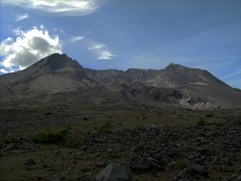 |
Research
Modelling Primary Succession on Mount St. Helens (MSH)
Instream Flow Needs (IFN)
Canadian Aquatic Invasive Species Network (CAISN)
Polar Bears (PBR)
Dynamics of Insect Populations (DIP)
|
 |
| |
|
|
| |
Modelling Primary Succession on Mount St. Helens (MSH)
Since the eruption of Mount St. Helens in May 1980, researchers have been monitoring the progression of primary succession on its slopes. Many mechanisms have been proposed to explain how primary succession unfolds, though few have been explored in mechanistic models. Working with MSc student, Justin Marleau, John Bishop of Washington State U and Bill Fagan of the U of Maryland, models have been developed to test the importance of these mechanisms on Mount St Helens. Insights gleamed from these models could one day be applied to restore ecosystems damaged by mining and natural disasters.
Canadian Society for Ecology and Evolution (CSEE)
Publications & Affiliated Researchers |
|
| |
Instream Flow Needs: A Mechanistic Model-based Approach (IFN)
This project focuses on impacts of changing water flow on the biological interactions in Alberta rivers. It is a collaborative venture involving researchers at the Centre: Lewis, graduate student Hannah McKenzie, visiting students Michael Sieber and Nils Kehrein (Osnabrueck, Germany), postdocs Bill Nelson (now a faculty member at Queens) Frank Hilker (now faculty at Bath) and Yu Jin (Alberta), Ed McCauley, Calgary, and Frithjof Lutscher, Ottawa, with funding from AIF fellowships. Funding from Alberta Sustainable Resource Development grant involves additional researchers at Alberta and at Alberta Fish and Wildlife. This year we also received additional major funding from the new Alberta Ingenuity Water Centre as part of a large inter-university collaborative group (Ed McCauley PI).
Publications & Affiliated Researchers |
|
| |
Canadian Aquatic Invasive Species Network (CAISN)
This Canada-wide network of researchers studies spread and control of aquatic invaders. It involves interactions between academics and the Department of Fisheries and Oceans and is funded by an NSERC Network grant. Lewis, Lele, visiting student, Meike Wittmann, graduate student Harshana Rajankaruna, postdoc Jim Muirhead, and research associate Alex Potapov are Centre personnel involved in network research. Lewis directs the local research.
Publications & Affiliated Researchers
CAISN Website |
|
| |
Polar Bears (PBR)
Polar Bears (PBR)
A collaborative research venture involving polar scientists (Prof.
Andrew Derocher, Biological Sciences, Gregory Thiemann, York University, and Dr. Martyn Obbard, Ontario Ministry of Natural Resources), postdoc Péter Molnár, graduate student Marie Auger-Methe, and Lewis.
There are three projects: 1) Mathematical models to predict the effects of a sex-selective harvest on polar bear reproduction and population dynamics; 2) Mathematical models to predict climate warming impacts on polar bear body condition, reproduction and survival; and 3) State-space models to understand polar bear behaviour in relation to sea ice and their prey.
Publications & Affiliated Researchers
News |
|
| |
|
| |
|
| |
Dynamics of Insect Populations (DIP):
Mathematical modeling to investigate dynamics of insect populations includes modeling dynamics of forest catepillars and analysis of two-cycle dynamics in the Rocky Mountain Apollo butterfly under climate change. Researchers include graduate student Jeanette Wheeler (now a PhD student at MIT), former postdocs Caroline Bampfylde (now a Research Scientist with Alberta Environment) and Christina Cobbold (now a faculty member at Glasgow), Jens Roland (Biological Sciences), and Mark Lewis. This research is supported through AIF and NSERC. This year, a new offshoot of the research was a two-year international working group funded at the US National Institute for Mathematical and Biological Synthesis (NIMBios).
Publications & Affiliated Researchers |
|
| |
Parasitic Sea Lice in Salmon (SLS)
Sea Lice in Salmon (SLS):
This work involves researchers from Alberta, Victoria, Salmon Coast Research Station, University of Hawaii and others. Researchers from Alberta include Lewis and Subhash Lele (Math & Stat Sciences), as well as former graduate student Marty Krkosek (now a faculty member at Otago, NZ). Here, the ability to analyze the system using mathematical and statistical models has been key in the ability to understand complex dynamics.
A project involving graduate student Jaime Ashander (now a PhD student at Davis) investigated the evolutionary dynamics of sea lice under pesticide control. A new graduate student, Stephanie Peacock, will undertake adaptive management analysis of the use of pesticides on sea lice control and conservation of wild salmon. An article has been published in Frontiers in Ecology and the Environment. Funding for the study comes from the International Graduate Training Centre (IGTC) and MITACS.
Publications & Affiliated Researchers |
|
| |
Animal Movement Modelling (AMM)
This work models animal movement, using mechanistically detailed processes describing how animals respond to environmental, resource and conspecific cues. There are a variety of subprojects, ranging from wolf movement in the Alberta foothills, to more abstract models for swarming and group formation. The research is funded by NSERC and PIMS. Centre faculty includes Lewis and de Vries; trainees include PhD Candidates Marie Auger-Methe, Raluca Eftimie (now a postdoc at McMaster) and Hannah McKenzie, postdoc Frederic Hamelin (now a faculty member in Rennes, France) and former postdoc Frithjof Lutscher (now a faculty member at Ottawa). Other participants include Evelyn Merrill and Andrew Derocher (both with Biological Sciences).
Publications & Affiliated Researchers |
|
| |
Infectious Disease Modelling (IDM)
This work models the dynamics of infectious diseases in wildlife and human populations. Diseases include West Nile virus, Feline Immunodifficiency virus, and tuberculosis. Former postdocs Frank Hilker (now a faculty member at Bath) and Tomas de Camino-Beck (now a faculty member at Costa Rica), Research Associate Marjorie Wonham (now a faculty member at Quest University), Lewis and many external collaborators worked on this research. Modeling infectious disease transmission led by Wang includes three subprojects: modeling indirectly transmitted infectious diseases such as cholera (in collaboration with Richard Joh, Joshua Weitz and Howie Weiss in Atlanta and graduate student William Davis), devising a new algorithm to recover the time-dependent transmission rate from epidemiological data via an inverse method (in collaboration with Howie Weiss in Atlanta and Mark Pollicott in UK), abstract modeling of infectious disease transmission with waning immunity (in collaboration with graduate student, Nicholas Piazza). Three papers have been published: in Ecological Modelling, the American Journal of Veterinary Research, and the Bulletin of Mathematical Biology, and two articles were published in Mathematical Biology. This work is funded by NSERC and U of Alberta Startup Funds.
Publications & Affiliated Researchers |
|
| |
Mountain Pine Beetle Modeling (MPB)
A three-year collaborative project with members from Renewable Resources (led by Fangliang He), Canadian Forest Service and Math/Stat Sciences (led by Lewis) was funded by the NRCan Mountain Pine Beetle Initiative, and finished in March 2007. The group developed a new computational and statistical predictive model for the spread of MPB, as well as many other quantitative models and publications.
This work led to a new collaboration between Lewis and Canadian Forest Service scientist Barry Cooke and Research Associate Mario Pineda Krch as part of the Alberta MPB Genomics TRIA project. Other UA faculty involved in the project include Subash Lele (Math & Stat Sci), David Coltman, Janice Cooke and Felix Sperling (Biological Sciences).
Funding: NRCan Canadian Forest Service
Publications & Affiliated Researchers
Website |
|
| |
Other
Other projects include modelling species diversity, chaotic dynamical systems in biology, and the theory of differential games in biology.
Publications & Affiliated Researchers
|
|
© 2004, Lewis Research Group, University
of Alberta. All Rights Reserved.














